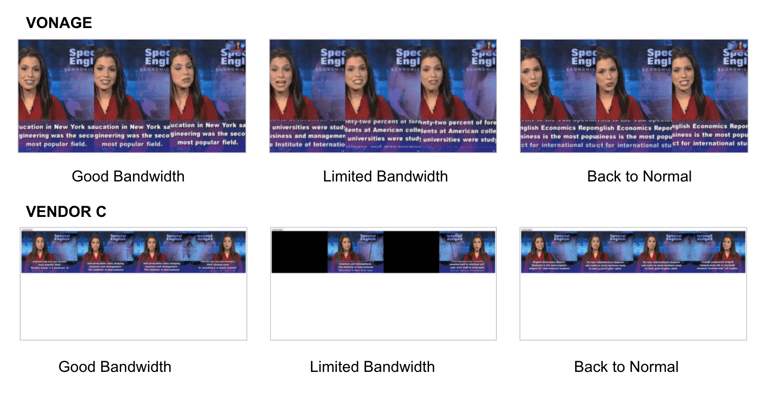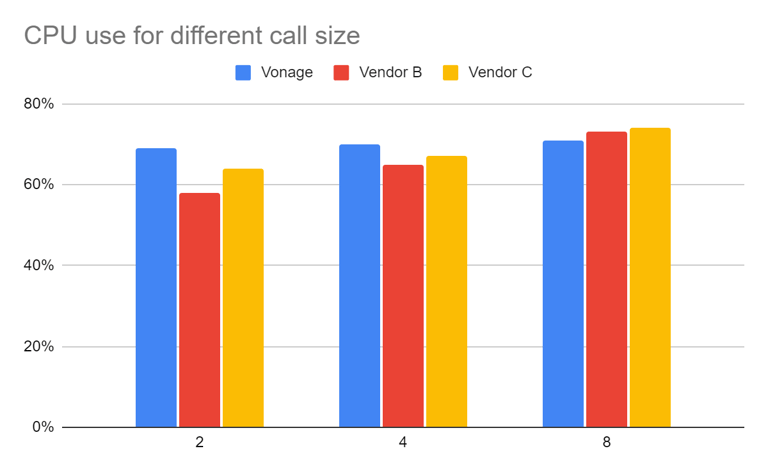Vonage Is Raising Video Quality for Live Interactions in the Post-Pandemic Era
A recent study by industry leading webRTC testing and monitoring service testRTC provides a comparative analysis of the Vonage Video API against prominent Video API vendors.

It is incredible to think back to where we were a year ago. COVID-19 has challenged us to transform our ways of working, living, and relating to each other. Video communications exploded to help us adjust to the new way of living—Video minutes on Vonage Video Platform increased by 707 percent between February and April of last year, and total video minutes remained high, with July 2020 usage at 501 percent over February 2020 usage (from the Vonage Video Trends Report, July 2020).
Even though we’re now beginning to see an end to the pandemic on the horizon in parts of the world, this transformation to the “new normal” is here to stay. For many of us, our new normal includes having video meetings with multiple colleagues to exchange ideas, meeting the doctor on a telehealth app, or connecting to an interactive video classroom —all using the same broadband connection.
Industry-leading education technology provider and Vonage customer Top Hat provides educators and students with the interactive content, tools, and activities they need for active learning.
“By building Vonage’s Video APIs into our digital courseware platform, Top Hat has effectively supported educators to deepen student engagement and enable human connection during a time when student isolation, anxiety, and motivation has become a top concern,” said Nick Stein, Chief Marketing Officer, Top Hat. “Whether being used in large-class settings or one-to-one office hours, the ability to connect with students using Vonage’s video capabilities has helped students to feel more connected with their learning, with their instructors, and with each other.”
Given this unprecedented surge in video communications, especially for video calls between multiple participants, it is not hyperbolic to say that Video applications are expected to do more with less—deliver more participants and better quality of experience, all with limited bandwidth.
At Vonage, we are passionate about video quality. We are committed to delivering video streams with the best quality possible, regardless of constraints within network bandwidth or client devices—the two factors that have the most impact on the user experience. We continuously work towards this goal through various efforts.
The pandemic has underscored the need for secure, reliable, and privacy-compliant video offerings, particularly when it comes to providing the remote delivery of vital services like education and healthcare, and just as vital to most of us—our entertainment and social connectedness.
Vonage has been enabling businesses to leverage the Video API for years to deliver rich video capability directly into existing applications and workflows. The biggest challenge and the priority for 2020 was to scale to keep our customers online and in business. But it wasn’t just that people were doing more video in 2020; they were also doing it with more people and encountering the challenges that come with that.
The Post-Pandemic Challenges
Previously, video was typically used for one-on-one calling. The way we use video has shifted dramatically over the last year. Not only are we using video to connect with our colleagues, students, patients, and friends more than ever, we are often meeting with more people at one time and for longer. This means, for best quality experience in group calls, the video application must deliver an appropriate video stream, possibly with different resolution and bitrate for each participant in the call, based on their device and available bandwidth, and at the same time optimize for CPU usage.
A recent study by industry leading webRTC testing and monitoring service testRTC provides a comparative analysis of Vonage Video API against the prominent Video API vendors in the market (download the full report). testRTC built a test bed with objective metrics to evaluate the video quality of three prominent Video API vendors in the market.
Video Quality Assessment of 1:1 and Multiparty Video Calls
When we set out to conduct this performance analysis, we strived to create a stable and repeatable environment with a third party in order to enable an objective analysis.
As part of this project, testRTC has written the applications used in front of the Video API vendors, defined and implemented test scenarios using the testRTC platform, conducted the testing, and analyzed the results.
The test compared Vonage Video API to two leading webRTC video vendors in their standard browser-based implementations of the underlying webRTC specifications.
For each of the three vendors, we tested four different use cases with three different group sizes—2, 4, and 8 participants. This got us to a total of 36 scenarios, each of which was executed multiple times to validate repeatability as well as stability of the scenario. We wanted to make sure results were reproducible and not random in nature.

Benchmarked Scenarios
The benchmarks findings showed Vonage Video API outperforming the other two vendors with the ability to deliver high quality video while maintaining low bandwidth. While the study tested several common use cases, results indicated that the quality optimizations were the most pronounced and therefore had the most impact on the user experience in the following scenarios:
SCENARIO ONE: Quality Under Transient Network Conditions
Under the current circumstances where many people are on a shared network, it is not uncommon for the bandwidth to have sudden changes for a short period of time. This can happen when someone in the network is consuming a lot of bandwidth capacity or if you are switching from one network to another. According to testRTC: “Vonage was able to nicely cope with a reduction of bitrate, recovering the video quality within 15-25 seconds after conditions normalized, while the other vendors had a more challenging time dealing with the bandwidth adjustments which affected the overall call quality and experience.”
Improving performance in low bandwidth
In recent months, Vonage has rolled out many important changes in bandwidth estimation and bitrate adaptation. With these changes, Vonage is able to:
Speed up the bitrate ramp up for simulcast subscribers, so subscribers can reach higher video qualities sooner, resulting in better user experience
Ensure faster recovery to a better quality with faster bitrate ramp up to changing bandwidth conditions, resulting in fewer frame freezes during bandwidth dips
.png)

SCENARIO TWO: Quality Under Normal Network Conditions
Achieving Good Quality at a Lower Bitrate
Getting good quality out of real-time video is a factor of the available bandwidth as well as how well the API is utilizing this bandwidth. Many Video API vendors waste a lot of bandwidth to reach the same qualities by using higher bitrates than needed. This problem becomes more magnified as the call size increases. To mitigate this, Vonage recently introduced a maxbitrate feature that compresses the qualities closer together and reduces the network-proving effort required to ramp up, and thus speeds the ramp up to the maximum meaningful quality without wasting any bandwidth. Targeting for 4mbps or more in incoming video bitrate isn’t the best decision for most users today. It eats up the bandwidth as well as CPU resources of the receiving machine, and in many cases can cause the session to fail altogether.
Optimized CPU Utilization for Larger Group Calls
For most multiparty applications, it is essential to tune the layout parameters to get to a good quality experience. Vonage provides APIs to tune the resolution and frame rate for the subscribers; this, combined with recent performance optimizations in the audioLevelUpdated event, resulted in lower CPU consumption in large group calls. Vonage also uses simulcast, allowing our SFU to send different qualities to each participant in a group call based on their available bandwidth and their device capacity. This also lowers the CPU consumption and provides a better quality experience to the users.

SCENARIO THREE: Quality of Screen Share Content
Screen sharing is a powerful feature of video calls - allowing participants to stream content of an application window, in addition to, or instead of, their video streams. This opens up a whole new world of possibilities, as well as complications for your webRTC setup. Screen sharing requires the platform to cope with a variety of content types - from static slides to motion videos.
Participants in Vonage Video API sessions fared better than the other vendors with screen sharing content—both static and dynamic (like sharing videos), and the performance differential was especially pronounced the more participants there were in a session. When screen sharing, Vonage immediately lowers the bitrate of all incoming video streams to the lower available layer, giving priority to the screen sharing video stream. This enables them to invest higher bitrate and CPU resources for screen sharing as the size of the meeting grows.
%20stream%20is%20prioritized.png)
%20is%20not%20prioritized.png)
%20is%20not%20prioritized.png)
In the Video API, we optimize for the frame rate and resolution to accommodate various screen share content types. A setting was added to specify a minimum bitrate on a stream, which means that if you enable it, the platform will stop sending video or screen share as soon as the bandwidth estimation goes below the minimum bitrate (on subscriber side). This will ensure that the end user below a certain bandwidth will not receive a stream instead of receiving a bad quality stream. A way to provide media-ContentHints from the client was also added so that the media track is encoded and processed with the methods that are more appropriate to the type of the content that is being consumed, hence ensuring good quality for the content shared on the screen.
Looking Ahead: Raising the Quality Bar for Live Video Calls
The events of the last year have challenged many prior assumptions that were made about the need for video applications, which has led us to think about more efficient strategies to build applications that provide a better quality experience to users in large group calls and to users in constrained network conditions. At Vonage, we continuously strive to push the boundaries on improving video quality. We are continuing to innovate with the ultimate goal of more efficient bandwidth usage and good video experience for all the participants in the call. To that end, we are currently experimenting with more efficient rate control and CPU optimization strategies that can be applied to a wide range of device profiles for small and large group calls.
To keep up with our work in Video and Communications API, check out learn.vonage.com.
